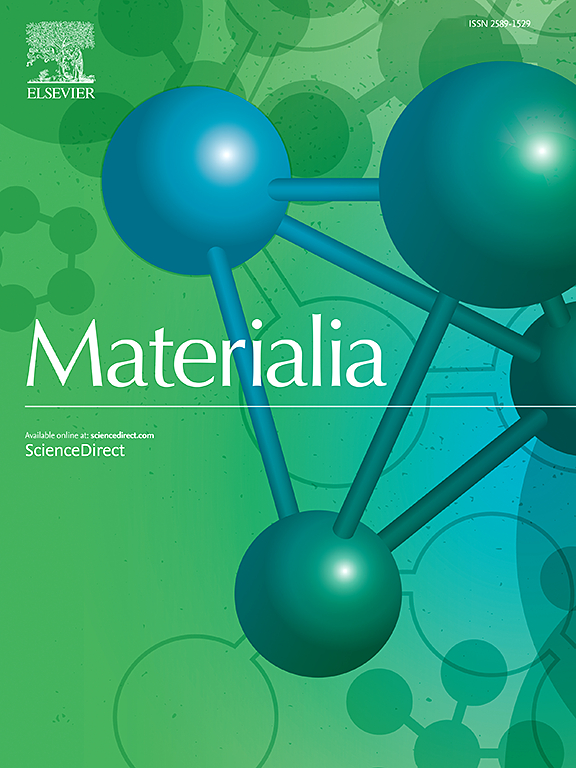Deformation-induced Au precipitation kinetics in Fe-Au-W alloys studied by time-resolved small angle neutron scattering
IF 3
Q2 MATERIALS SCIENCE, MULTIDISCIPLINARY
引用次数: 0
Abstract
In-situ time-resolved small-angle neutron scattering (SANS) experiments were conducted on homogenised cold-rolled ternary Fe-Au-W alloys during aging for 12 h at temperatures of 650 to 700 °C in order to study the kinetics of the nanoscale precipitation. For comparison the precipitation kinetics in the binary counterparts Fe-Au and Fe-W alloys were also studied. In the ternary Fe-Au-W alloy nanoscale Au-rich precipitates were observed by both transmission electron microscopy (TEM) and SANS, while no significant W-rich precipitation was observed. The SANS pattern of the cold-rolled Fe-Au-W alloy clearly reveals a preferred orientation for the plate-shaped nanoscale Au-rich precipitates. As these Au-rich precipitates have a fixed orientation relation with the matrix lattice this preferred orientation originates from the texture of the bcc matrix grains, as confirmed by X-ray diffraction (XRD) pole figure measurements. The effect of texture on the nuclear and the magnetic SANS signal during the precipitation kinetics was included in the data analysis. This enables us to monitor the temperature dependence of the precipitation kinetics for the Au-rich precipitates in the Fe-Au-W alloy during aging at temperatures of 650, 675 and 700 °C. It is found that an increase in aging temperature results in a faster kinetics and a lower final precipitate fraction.

用时间分辨小角中子散射研究Fe-Au-W合金中变形诱发的Au析出动力学
采用原位时间分辨小角中子散射(SANS)实验,对均匀冷轧Fe-Au-W三元合金在650 ~ 700℃时效12 h的过程中进行了纳米级析出动力学研究。为了比较,还研究了Fe-Au和Fe-W二元合金的析出动力学。在Fe-Au-W三元合金中,透射电镜(TEM)和SANS均观察到纳米级富金析出,但未观察到明显的富w析出。冷轧Fe-Au-W合金的SANS模式清楚地揭示了板状纳米级富金沉淀的优先取向。由于这些富金析出物与基体晶格具有固定的取向关系,x射线衍射(XRD)极点图测量证实,这种偏好取向源于bcc基体晶粒的织构。在数据分析中考虑了织构对析出动力学过程中核和磁性SANS信号的影响。这使我们能够监测在650、675和700℃时效过程中Fe-Au-W合金中富au析出物的析出动力学的温度依赖性。结果表明,随着时效温度的升高,时效动力学加快,终相析出率降低。
本文章由计算机程序翻译,如有差异,请以英文原文为准。
求助全文
约1分钟内获得全文
求助全文
来源期刊

Materialia
MATERIALS SCIENCE, MULTIDISCIPLINARY-
CiteScore
6.40
自引率
2.90%
发文量
345
审稿时长
36 days
期刊介绍:
Materialia is a multidisciplinary journal of materials science and engineering that publishes original peer-reviewed research articles. Articles in Materialia advance the understanding of the relationship between processing, structure, property, and function of materials.
Materialia publishes full-length research articles, review articles, and letters (short communications). In addition to receiving direct submissions, Materialia also accepts transfers from Acta Materialia, Inc. partner journals. Materialia offers authors the choice to publish on an open access model (with author fee), or on a subscription model (with no author fee).
 求助内容:
求助内容: 应助结果提醒方式:
应助结果提醒方式:


